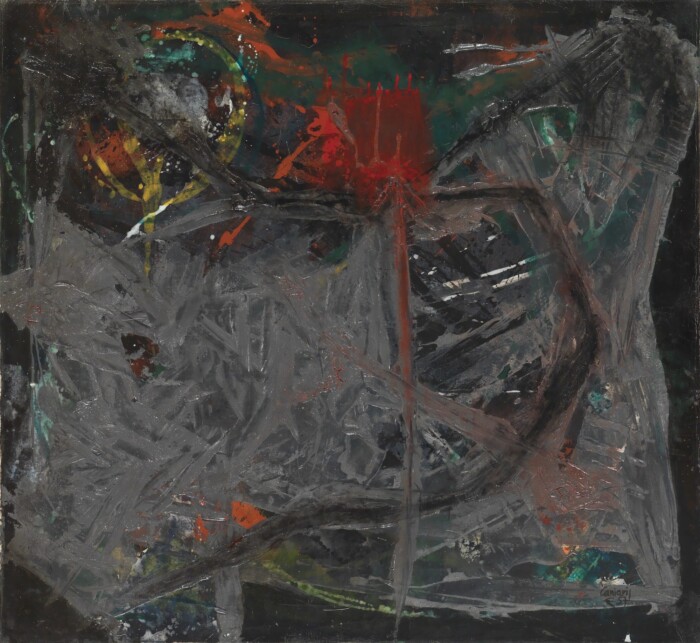| 16 |
Greek, 1928-2011
The catastrophe of Marcinelle
acrylic on canvas
signed and dated ’57 lower right
signed retrospectively in 2004 on the reverse
100 x 92 cm
PROVENANCE
private collection, Athens
LITERATURE
Michael Fehr, Vlassis Caniaris, Verlag fur modern Kunst, Nuremberg, 1991, page 163, image 57/11 (illustrated)
| sold for 9,428.00 € |
Vlassis Caniaris was born in 1928 in Athens where he died in 2011.
In 1950 he abandoned five years of medical studies and enrolled at the School of Fine Arts, Athens to study under Oumbertos Argyros, Yiannis Pappas and the then newly appointed Yiannis Moralis.
Shortly after his graduation, he settled in Rome (1956). His first solo show in Athens at Zygos Gallery (1958), where he exhibited a series of canvases, was one of the earliest presentations of abstract art in Greece. His next series, ‘Tribute to the walls of Athens’, was created with layers of plastered paper.
In 1960 he settled in Paris where he came into contact with the group Nouveaux Realistes and Pierre Restany. He abandoned the conventional canvas and started to experiment with everyday materials such as metal mesh, wire and plaster. Soon he includes pre-formed objects and mannequins in his work.
In 1964 he participated in Pierre Restany’s much-debated exhibition 'Three Proposals for a New Greek Sculpture' along with Daniil and Kessanlis, a parallel event of the 32nd Venice Biennale. This is the first time Caniaris presented his organized environments of mannequins, preformed and real objects.
In 1969, just two years after the abolition of Greek democracy by the military junta, Caniaris’ exhibition at the New Gallery in Athens, featuring constructions in plaster and barbed wire, provoked sensational reactions both as an innovative artistic approach and as an anti-dictatorship demonstration. The artist was forced by the regime to leave Athens and return to Paris. The following year he exhibited the same anti-dictatorship exhibition at the Musee d’Art Moderne in Paris.
Between 1973 and 1975 Caniaris moved to Berlin. There he was able to complete the Gastarbeiter-Fremdarbeiter series (inspired by the world of immigrant workers who streamed into Germany from other mostly Balkan countries) that included installations of clothed, barbed wire dummies and everyday objects. This series was exhibited in the German museums: Kunstverein Hannover, Kunstverein Heidelberg, Kunstverein Ingolstadt and Museum Bochum and in 1976 was exhibited in London at the Institute of Contemporary Arts (ICA).
In 1975 he was elected a professor at the School of Architecture of the National Technical University of Athens, a position he held until his retirement in 1996.
Caniaris held several prestigious solo exhibitions. Notably the 1977 Documenta 6 in Kassel, in 1990 at the Karl Ernst Osthaus Museum in The Hague, in 1991 at the Staatliche Kunsthalle in Berlin, in 1999 at the National Gallery of Greece, in 2000 at the Macedonian Museum of Contemporary Art and in 2008 at the Benaki Museum.
In 1988 he represented Greece at the Venice Biennale together with Nikos Kessanlis and in 1996 participated at the ‘Face a l’Histoire: 1933-1996’ at the Pompidou Center.
His work is found in many private and public collections, notably: The Tate Modern, the Musee d’Art Moderne de Saint-Etienne, the Osthaus-Museum Hagen, the National Gallery of Greece and the National Museum of Contemporary Art of Greece.
